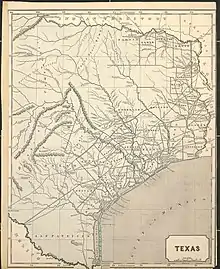
Cerography or glyphography is a printmaking technique related to engraving, using a layer of wax over a metal substrate. After the image is engraved into the wax, a positive plate is produced through stereotyping or electrotyping. This plate can be used with conventional letterpress equipment.
The word is derived from the Greek Ancient Greek: κηρός, wax, and Ancient Greek: γράφειν, to write).[1]
Cerography was invented in the late 1830s by Sidney E. Morse, a son of Jedidiah Morse, and a younger brother of Samuel Morse; it was independently patented in England by Edward Palmer, who primarily conceived of it as an artistic medium. Its primary use, however, was for line drawings, and in particular maps. It was easier than copperplate engraving and allowed lines and printed text to be combined easily in a single plate (the text could simply be stamped into the wax). It also allowed for color illustration. As compared to lithography and copperplate it had the disadvantage that it could not reproduce fine shading well. Tones were added by scoring fine parallel lines 100-150 per inch or by rolling stippling spikes over the surface of the wax to create parallel dotted lines.[2]
The technique remained popular to the end of the 19th century but was gradually pushed out by photoengraving.
See also
References
- ↑ Chisholm, Hugh, ed. (1911). . Encyclopædia Britannica. Vol. 5 (11th ed.). Cambridge University Press. p. 762.
- ↑ Woodward, David (1977). The all-American map : wax engraving and its influence on cartography. Hermon Dunlap Smith Center for the History of Cartography. Chicago: University of Chicago Press. pp. 61–62. ISBN 0-226-90725-2. OCLC 2464510.
- Purinton, Nancy (2003). "A Historical Map-Printing Technique: Wax Engraving". Journal of the American Institute for Conservation. 42 (3): 419–424. doi:10.1179/019713603806112688. S2CID 192085117. Retrieved 2016-02-18.